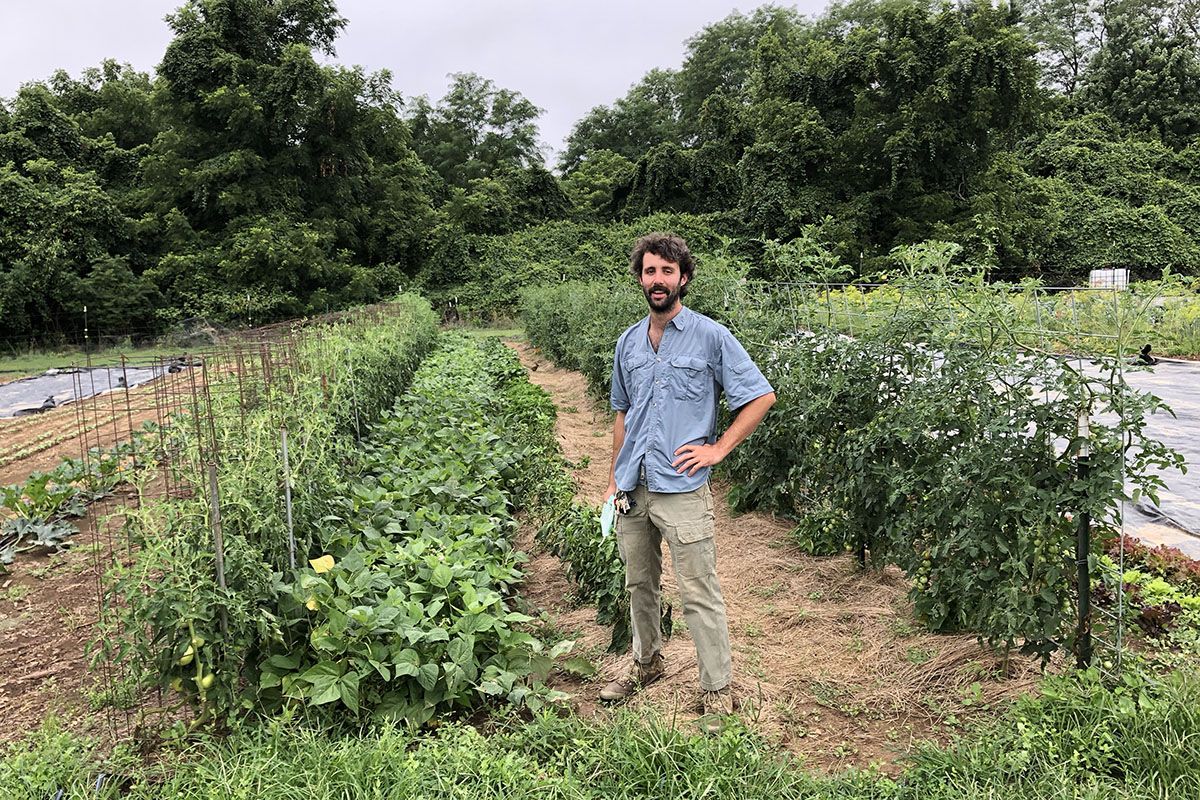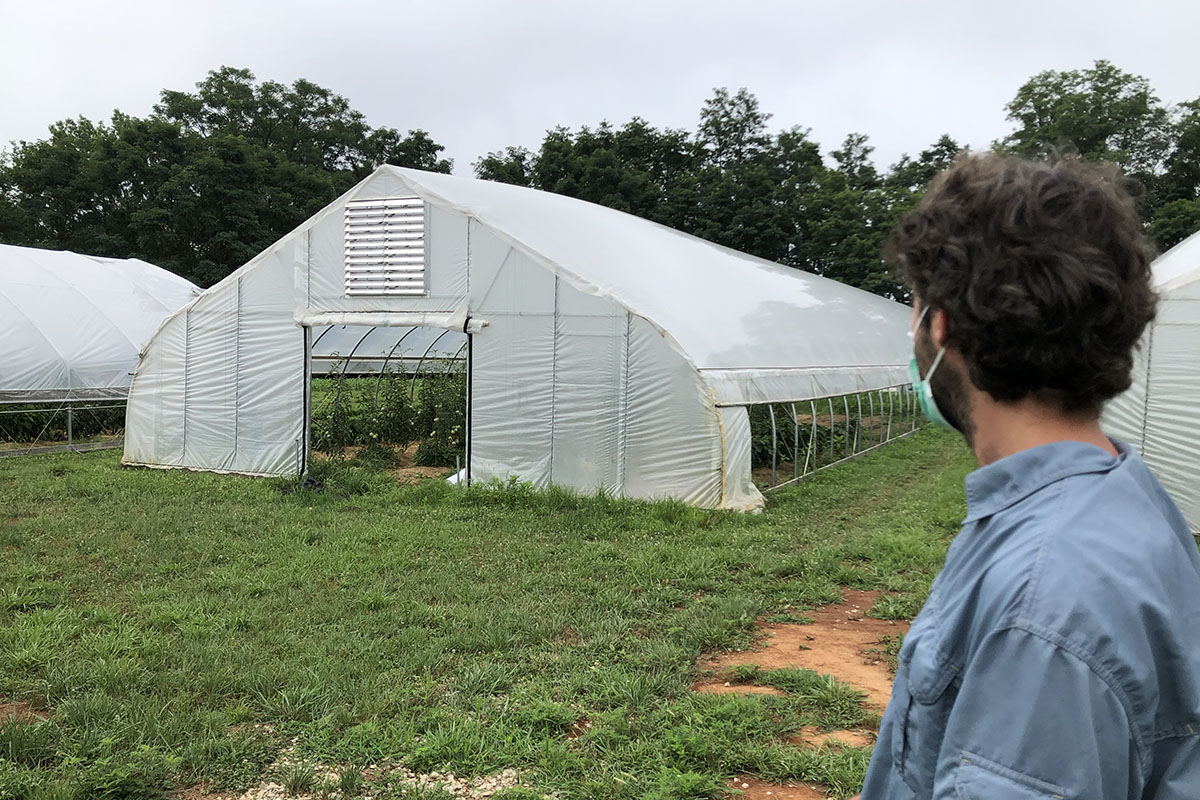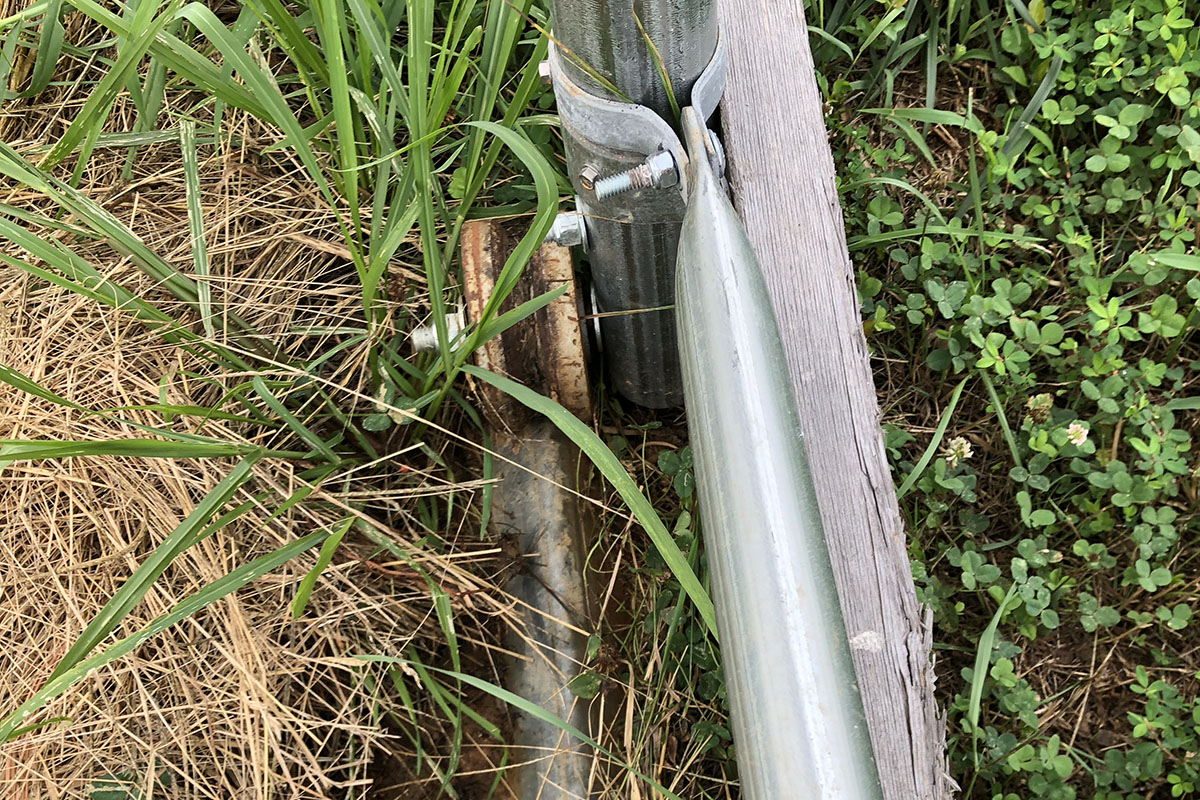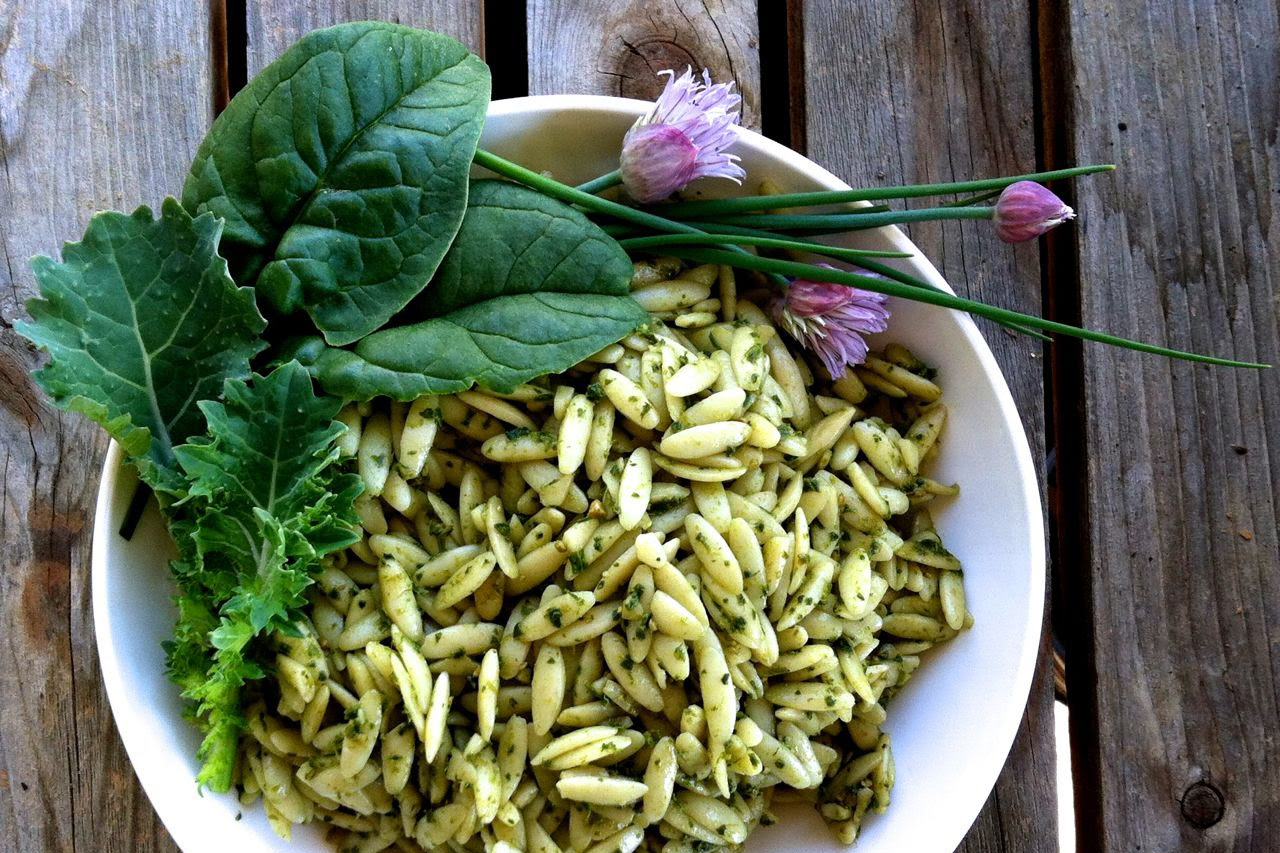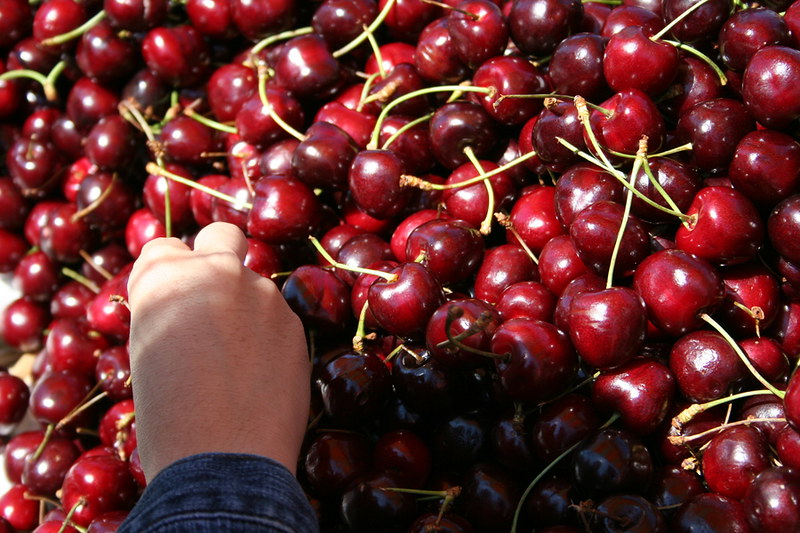KAYTE YOUNG: Production support for Earth Eats comes from:
Bloomingfoods Coop Market, providing local residents with locally sourced food since 1976. Owned by over 12,000 residents in Monroe County and beyond. More at Bloomingfoods.Coop.
And Elizabeth Ruh, Enrolled Agent with personal financial services. Assisting businesses and individuals with tax preparation and planning for over 15 years. More at PersonalFinancialServices.net
(Earth Eats theme music, composed by Erin Tobey and performed by Erin and Matt Tobey)
From WFIU in Bloomington Indiana, I'm Kayte Young and this is Earth Eats.
ERIN CARMEN-SWEENY: Winter-kill cover crop is like the most beautiful thing because it's gonna do all of the work for you, basically, and get you to where you need to.
KAYTE YOUNG: This week on our show we speak with IU campus farm manager Erin Carmen-Sweeney about regenerative agriculture practices and how they can come in handy when you start a farm on land without any topsoil. Harvest Public Media has a story about goat farmers contracting with forest managers for removal of invasive plants. And it's pesto season, we'll walk through the steps of harvesting your basil and turning it into a tasty pasta sauce to last you all winter long. That's all just ahead so stay with us.
Let's start with food news from Renee Reed. Hello Renee.
RENEE REED: Hello Kayte. Farmers across the country have faced labor shortfalls as seasonal workers have skipped harvest season during the pandemic. The worst hit crops require the most of the amount of labor, such as cherries, plums and apples.
Unlike many crops, cherry repel machine harvesters and other labor-saving production tools, because of their fragile nature. They have to be picked by skilled hands and shipped right at the moment of ripeness. That shortens the window to get them to retail shelves and makes them more subject to splitting and bruising along the way. The Washington State Tree Fruit Association says that during an 8-week harvest season for cherries, up to 24 billion individual cherries have to be picked and sorted before getting shipped to market.
Even before COVID-19 the number of seasonal farm workers often immigrants without legal permission to work had dropped in recent years. Many have left the industry due to poor pay, exploitation and border crack downs. But labor shortages due to the pandemic this year have left farmers desperate to find help during harvest leaving a wake of crops rotting in the fields. The Seattle Times reported this week that in Okanagan county Washington, cherry pickers described lapses in safety measures against coronavirus, such as failure to do daily temperature checks or neglecting to report signs of illness to keep workers in the field. Many workers went home in July due to fear of rising infection rates on farms. Seasonal contracts normally extend to November.
After COVID-19 closed meatpacking plants and slashed ethanol demand, agriculture markets plummeted. While prices have improved, Nathan Kauffman at the Kansas City Federal Reserve thinks farm incomes could stay low into 2021.
NATHAN KAUFFMAN: In an environment where there are substantial concerns about the broader economy and demand growth, the outlook for prices is still relatively weak.
RENEE REED: Congress will float many farms this year with billions in aid. But Kauffman says payments have their limits. Farm income has been falling for years due to low prices.
NATHAN KAUFFMAN: The government support will offset some of it in the short term, but it doesn't necessarily resolve what had already been building.
RENEE REED: And while it's too early to tell, Kauffman says some markets like beef could see another drop in demand as grocery store prices continue rising. Thanks to Christina Stella of Harvest Public Media and Chad Bouchard for those reports. For Earth Eats News, I'm Renee Reed.
(Earth Eats News Theme)
(Swanky music)
KAYTE YOUNG: College campuses are opening up or going virtual or something in between all across the country this month. And here in Bloomington the students have arrived, and classes start next week. I thought it might be a good time to visit the IU campus farm and talk with farm manager Erin Carmen Sweeney.
ERIN CARMEN-SWEENY: We are walking around the IU campus farm which is at the Hinkle Garden Farmstead.
KAYTE YOUNG [NARRATING]: The farm is located on 10th st, west of the bypass in Bloomington. They focus on fruit and vegetable production and distribute the harvest to students through IU dining services, to the general public through farm stands, and to those in need of food assistance through donations to Mother Hubbard's Cupboard. Erin Carmen Sweeney grew up on an organic farm, but truly discovered his passion for sustainable food systems after he left home.
ERIN CARMEN-SWEENY: I went off to college and the summer reading that they made my entire freshman class do was Omnivore's Dilemma and it was like wow, you know the world is trying to teach me that the way I've been raised and grown up is a good an important way to be producing our food in the way we should be producing our food.
(I) got more interested in it from a different perspective, it was never like an academic thing for me growing up. It was just like this is what we do, and then I started to study and realize all of the problems with the larger industrial food system.
KAYTE YOUNG [NARRATING]: Erin has a degree in geography and environmental resources and loads of experience in growing food and sharing farming skills with others. He's been running the farm from the beginning and it's a good fit. With about five acres for crop production, the farm hosts four high tunnels and several large open airfields for growing specialty crops. Erin gave me a tour of the farm at peak growing season starting with the first area they planted.
ERIN CARMEN-SWEENY: This is our main growing area for 2018-2019 and this year because this is the only part of the property where the soil wasn't stripped, all the topsoil wasn't stripped away.
KAYTE YOUNG [NARRATING]: The farm faced a huge challenge when they first broke ground in 2017 due to the condition of the land itself. At some point one of the heirs of the garden estate was looking at developing the site for condos or apartments and sold off the topsoil.
[INTERVIEWING] I didn't even know that was a thing that you can sell topsoil.
ERIN CARMEN-SWEENY: Oh yeah, people buy topsoil. You can go to Speedway and buy topsoil and it's just you know soil that they stripped off the land somewhere because they wanted to flatten it. Anytime, if you're anywhere near a building the topsoil that you're dealing with is very likely not the native topsoil.
KAYTE YOUNG [NARRATING]: Okay, good to know. Earlier I said the farm is dedicated to growing specialty crops. What that basically means is fruits and vegetables as opposed to corn and soybeans which are the typical Indiana crops.
ERIN CARMEN-SWEENY: Beans there's some kombucha squash, butternut squash, more beans for the fall. This is our zucchini that we're just starting to pick so it's kind of... the timing has worked out to where like that stuff is fading and this stuff is just coming on. We've got a big row of a couple different colors of pink and yellow tomatoes, more beans, some peppers, there goes a rabbit! And some cherry tomatoes, and then this is our first year growing sweet potatoes.
KAYTE YOUNG [NARRATING]: In spite of the land being stripped down to hard pan clay, they've managed to build up the soil through an approach called regenerative agriculture. This includes methods such as winter-kill cover cropping.
ERIN CARMEN-SWEENY: Cover crops are great for a lot of reasons, which most people look into, but basically just having living roots in the soil. And then what I like to do is have a nice mixture of different plants and not just a single thing. Because the diversity basically when it dies, it can compost in place and provide those nutrients.
And for a couple reasons, that's a lot cheaper than buying compost. And you know people say well "Why don't you just make your own compost?" well at the scale that I'm at, I would need like industrial quantities of compost, and huge equipment to turn. So a cover crop can kind of create that biomass, that organic matter in plates.
And then the nice thing about a winter killed one, is that terminating it is not a problem, it's gonna die. So it's you know a warm season crop, like a buckwheat, this'll probably be like sorghum Sudan grass, sun hemp and buckwheat, which are all gonna die at the very first frost. And then they'll just be able to break down and be a mulch all winter, so they'll protect the soil and then by the time the spring comes around, almost all that material has fully like broken down into the soil. You might rake aside a little bit, but you can just get right into the soil and it's ready to go, and it's added some nutrients, and if you have a legume in there like in our case the sun hemp, it's gonna have some nitrogen for you.
So that's kind of our main fertility program because compost is just expensive and not always attainable, and obviously we're using organic methods so we're not bringing in like ammonium nitrate or anything like that.
Because we use cover crops and the way we approach farming, we call it regenerative agriculture. Trying to build life in the soil with all these different roots in the soil that attract different various microbes and fungi relationships. Like a winter-killed cover crop is the most beautiful thing because it's gonna do all the work for you basically and get you where you need to.
KAYTE YOUNG [NARRATING]: Some areas of the campus farms are used for research and experimentation, a sort of living laboratory for classes at IU. Textile artist and IU professor Rowland Rickles is growing indigo on the campus farm for projects in natural dying. Professor James Farmer who oversees the campus farm brings his students out for hands on learning in sustainable agriculture, and biology professor Heather Reynolds is conducting a trial on the use of living mulch.
ERIN CARMEN-SWEENY: So this like the living mulch of the clover is here, and she has a map of it so she can tell me better, and I think this one is like a...
KAYTE YOUNG [TO ERIC]: Vegetables or something
ERIN CARMEN-SWEENY: Vegs and rye that got mowed down. Then there's the straw one, and this one is a leaf mulch, stripped mulch. So there's these different mulching approaches, they're all no till, seeing which is most effective. And she did this trial, a larger scale trial, it took up this like whole plot last year, and she did on two other farms. And universally it seemed, I think, to find that the straw mulch was the most effective and that was pretty much the farmer control of what would you normally do? And so the living mulch is all the kind of more experimental stuff was found to be less effective. But there might be reasons to tweak it and try something else, try something slightly different.
KAYTE YOUNG [TO ERIC]: And maybe if it works but isn't the most effective, but it still works then maybe it's still worth trying out.
ERIN CARMEN-SWEENY: Yeah, totally.
KAYTE YOUNG: So this part over here looks more traditional with the straw.
ERIN CARMEN-SWEENY: Right, right. Effective but...
KAYTE YOUNG [NARRATING]: One of the agricultural experiments on the farm is managed by Erin and the other employees of the farm.
ERIN CARMEN-SWEENY: Basically we're comparing the open field to the movable high tunnel to the permanent high tunnel and seeing just how they perform. We're growing the same crops; we've got tomatoes and peppers in each of these spots for the summer anyway. A lot of people want to grow tomatoes in their tunnels because it's just a highly profitable crop and it's a good space to grow that. So they'll build the tunnel, and then they'll want to do that year after year. And it's like well, okay that's not great for the soil.
KAYTE YOUNG [NARRATING]: With organic growing methods it's not great for the soil to plant the same crop in the same place year after year because you can end up harboring pests and diseases in the soil that affect that particular crop. Ideally you rotate your crops so that one piece of land would have say tomatoes one year, then green beans the next year, then carrots the following year, and then you could return to tomatoes. Different types of crops deplete the soil of or supply the soil with particular nutrients as well.
ERIN CARMEN-SWEENY: But by having a movable tunnel I can move my tunnel and be growing tomatoes in it again next year on a new patch of ground that didn't have tomatoes in it yesterday.
KAYTE YOUNG [TO ERIN]: And grow something else where the high tunnel was.
ERIN CARMEN-SWEENY: Yeah exactly, and it encourages you again those cover crops, a lot of people don't ever plant cover crops in their tunnels because you want to do... you know your tomatoes in the summer and then you do your leafy greens in the fall and winter and you’re kind of always have it in some kind of cash crop. it's too valuable space to not do something like that. But with being able to move the tunnel then you have outdoor space where you can you know throw in the cover crop and kind of get a chance to revitalize that soil.
KAYTE YOUNG [TO ERIN]: Okay so you're calling these moveable tunnels but to me they look huge and really hard to move so what...?
ERIN CARMEN-SWEENY: This is all, there's a rail here, and this is a track. There's wheel on the rail, and then everything is just anchored in. So these cables connect it to the rail and then there's earth anchors there, but all that stuff comes right off. And then the walls, the walls flip right up, and then we've moved this with as few as four people. Just push it down the track, you know. You get a little grease on the ball bearings on the wheels and yeah it runs right along.
(Sound of track moving)
KAYTE YOUNG [NARRATING]: So yeah, these building size structures, the size of say a double wide trailer. They're basically an arched metal frame covered with translucent plastic sheeting. They're on tracks. You move them by rolling them on the tracks.
ERIN CARMEN-SWEENY: And we planted lettuces and greens and once that stuff was established and looking good, we moved it along so that we could go ahead and get our tomatoes planted and stuff for the summer.
KAYTE YOUNG [TO ERIN]: And you've got carrots galore right now it looks like.
ERIN CARMEN-SWEENY: Yeah replace that with carrots, yup. And then all of the first plot where it was, that's where it was over the winter, that's now all in a cover crop.
KAYTE YOUNG: Oh so there's like three sections total?
ERIN CARMEN-SWEENY: There's three sections, yup, yes.
KAYTE YOUNG: That's so great, I love it.
ERIN CARMEN-SWEENY: Yeah it's fun.
(Swanky music)
KAYTE YOUNG [NARRATING]: I really couldn't get over the brilliance of the system. It allows the grower to continuously use the covered structure season after season while rotating the crops for optimum soil health. This kind of research on the campus farm involves a lot of record keeping and documentation.
ERIN CARMEN-SWEENY: Just the recording of the data from the different tomato plots is about 25% of the labor of harvesting the tomatoes, right? So there will be like three people harvesting tomatoes and then one person like weighing them and being like "Okay this is from that plot, this is from that plot" and put it into a spreadsheet.
Record keeping it's a big part of it, and that's you know an aspect of research, an aspect of food safety, and just like good farm management, and knowing what amendments went down where, and what was planted where and keeping track of everything.
KAYTE YOUNG: That was Erin Carmen-Sweeny of the IU campus farm, you can find more about the farm on our website EarthEats.org.
Forests across the country have a problem with invasive plants wreaking havoc by choking off native plants and destroying wildlife habitats. A national forest in Missouri is experimenting with goats as a solution. Harvest Public Media's Jonathon Ahl reports it's a natural and cheap alternative to herbicides and mowing.
(Goats baying)
JONATHAN AHL [NARRATING]: Dozens of Spanish goats are roaming around a field in the Mark Twain National Forest in the Missouri Ozarks. The vegetation is about waist high, making it hard to see them from a distance. They are here to eat seralifil lesbasia a woody flowering herb native to Asia that makes this area uninhabitable for quail and turkeys. Brian Davidson is the botany and invasive species program manager at the Mark Twain National Forest, he says the goats are helping not only with what they eat, but also with what the leave behind.
BRIAN DAVIDSON: They're defecating all over that, so that gets incorporated in the soil. And it's a positive.
JONATHAN AHL [TO BRIAN]: So between what they eat and what they poop, they're the natural weed and feed?
BRIAN DAVIDSON: Yeah. What goes in comes out right? So in all of that has a lot of nutrients.
JONATHAN AHL [NARRATING]: The fields and glades in between large groups of trees are super important to the health of a forest. They provide habitat for wildlife, areas for wildflowers to grow that help bees and act as fuel breaks in case of a forest fire. But plants like blackberries and kudzu can invade and decimate those spaces. Davidson says nonnative plants can grow up to 10 feet high.
BRIAN DAVIDSON: They create a large canopy, they compete for nutrients, and then they push out and eliminate a lot of the desirable native species that we have.
JONATHAN AHL [NARRATING]: Davidson says that getting into these areas to cut away the brush is difficult and ineffective. Using herbicides can kill native plants and is bad for the environment. And the goats are quickly eating through the problem in this three-acre field. It will take just a day or two to clear out the weeds, leaving behind tall grasses. This goat herd belongs to Loren and Elizabeth Steele of Elk Creek Missouri. They contract with landowners to bring their goats in, set up temporary fences to control where they go, and the goats do the rest. Elizabeth Steele says they got the idea when they were looking for ways to keep trees from coming back to their own land that they had cleared.
ELIZABETH STEELE: It's a lot cheaper than running equipment over the land to get rid of those resprouts or using herbicides. And so we decided to use goats and then that started the process for us of looking at what the goats eat, and what they are effective on.
JONATHAN AHL [NARRATING]: The Steeles say one of the common misperceptions about goats is that they will eat anything. Loren says he often hears the old stories about goats eating tin cans, or the sweater right of a child at a petting zoo. But he says goats are not indiscriminate in their diets. And what makes them different is that they will eat plants that no other animal is interested in.
LOREN STEELE: So they're pretty picky, however they will eat a lot of stuff, particularly broad leaf plants, and they're not near as much as a grass eater. They eat some grass, but they concentrate on broad leaf and brushy-brows type species.
JONATHAN AHL [NARRATING]: The Steeles own about 1,500 goats and bring most of them out on jobs like this one at the Mark Twain National Forest. And while the process is very natural, this is a business. The $25,000 contract the Steels have with the forest service has specific benchmark for clearing plants from certain areas. But the goats don't seem stressed by the workload. Loren Steele says it’s a pretty good life for a goat.
LOREN STEELE: They get shipped to a new place on a regular basis so it's kind of like having a new smorgasbord on a regular basis, and so yeah I think it's pretty good.
JONATHAN AHL [NARRATING]: Using goats to control vegetation isn't new, the practice goes back to when the animals were first domesticated. What is new is the targeted approach in using precision planning to take out specific plants in particular areas. Davidson says the next step might be to take the goats out of the open areas and see what they can do among the trees.
BRIAN DAVIDSON: Where we have a lot of native hardwoods that are encroaching and impeding pine regeneration and also not maintaining that openness with all that regen we get, so we are using goats in there to try to maintain that structure.
JONATHAN AHL [NARRATING]: Davidson says he thinks forests will increase their use of goats to help maintain land because they continue to prove to be cheap, effective and natural. Jonathan Ahl, Harvest Public Media.
KAYTE YOUNG: Find more from this reporting collective at HarvestPublicMedia.org.
(Earth Eats production support music, composed by Erin Tobey and performed by Erin and Matt Tobey)
Production support comes from:
Bill Brown at Griffy Creek Studio, architectural design and consulting for residential, commercial and community projects. Sustainable, energy positive and resilient design for a rapidly changing world. Bill at GriffyCreek.studio.
Insurance agent Dan Williamson of Bill Resch Insurance. Offering comprehensive auto, business and life coverage, in affiliation with Pekin Insurance. Beyond the expected. More at 812-336-6838.
And Bloomingfoods Coop Market, providing local residents with locally sourced food since 1976. Owned by over 12,000 residents in Monroe County and beyond. More at Bloomingfoods.Coop.
(Rock music)
Pesto traditionally is made using a mortar and pestle. And I suppose everyone should try making it that way once, just so you know what it's like. But this time of year I'm struggling to keep up with everything in the garden, making hot sauce, canning salsa, making pickles, so I'll take all the time saving techniques I can find. We'll be making pesto in the food processor. But we start off in the garden.
(Sound of door opening)
It's late summer, the basil is flowering, so I'm just pinching back the center flowering part of each basil plant. And honestly you're doing the basil a service by cutting all this back because if you leave it to flower that's pretty much going to be the end of your basil for the season. So you want to be always pinching back the centers to keep the basil going. It's a good time to cut your basil back, harvest a bunch of it, and bring it inside, make some pesto.
(Sound of basil leaves being rinsed)
So then when we get it inside we're gonna wanna put the basil in one of our solids spinners if you've got one, if not you can just rinse it off in a colander.
I'm going to be making pesto today to go on a pizza. Later tonight I'm going to go to a friend's house who has just finished building an outdoor brick oven, and he's gonna be making pizza tonight and I'm gonna make some pesto that we can put on some of those pizzas. Alright and now it's all nice and clean. And fairly dry. So now we just need to gather up all the rest of the ingredients and put them all into the bowl of a food processor.
So I need to take all of the basil leaves off of the stems. You don't want those really woody stems inside your pesto.
(Sound of leaves being plucked from its stem)
We want a total of three cups of basil, kind of loosely packed. Everything doesn't have to be exactly measured out, but you do want to have a general idea of the proportions. And so that's where a recipe comes in handy for something like this. About three cups loosely packed basil leaves.
You're gonna want to set that aside, and then in the bowl of your food processor, you're going to put the garlic, the salt, and the pine nuts.
(Sound of garlic being cracked and peeled)
So I've got my two cloves of garlic in the food processor, and now I'm gonna add the pine nuts. Three tablespoons of pine nuts.
(Sound of pine nuts being measured into food processor)
Next we want to add the salt. And I would start with a teaspoon of salt and then you can adjust later for taste. And then we're gonna pulse that until it's finally chopped. So we've got the garlic, pine nuts and salt in the food processor.
(Sound of food processor whirring)
Next we'll add the three cups of loosely packed basil leaves and the olive oil. And the olive oil I'm just going to pour into the top of the food processor while it's processing.
(Sound of food processor whirring)
And that was one half cup of olive oil and now we're gonna add a half cup of parmesan cheese. And this is just kind of roughly grated, and then we're gonna blend that up.
(Sound of food processor whirring)
You'll want to scrape down the sides of your food processor.
(Sound of food processor being scraped and then whirring again)
And then as far as texture goes, a lot of people like to have that leafy feeling in their pesto. A lot of people want it just like velvety smooth almost like a paste, so that is up to you. I'm feeling like there's a tiny bit more olive oil in this one then I would like, so I would start with a quarter cup and then just add a tablespoon at a time until it's the consistency that you want.
Now it is time to taste, see if we need to adjust for salt.
Mm... now I think it's pretty good on salt, with the cheese in there it really helps. I also like to add just a little bit of lemon juice to mine, I like the acidity and I also feel like it helps keep the brightness of the green basil leaves.
(Food processor whirrs again)
Mm... yeah that's nice, I like the acidity of that lemon juice. And I just add a half teaspoon, teaspoon, not much.
So that is our basic basil pesto.
This is great to put on pasta, of course, any shape will do. You can spread it on toasts, you can put it on a pizza.
(Rock music)
This recipe along with so many others can be found by visiting EarthEats.org.
(Earth Eats theme music, composed by Erin Tobey and performed by Erin and Matt Tobey)
RENEE REED: The Earth Eats team includes Eobon Binder, Chad Bouchard, Mark Chilla, Abraham Hill, Taylor Killough, Josephine McRobbie, the IU Food Institute, Harvest Public Media and me, Renee Reed. Our theme music is composed by Erin Tobey and performed by Erin and Matt Tobey. Earth Eats is produced and edited by Kayte Young and our executive producer is John Bailey.
KAYTE YOUNG: Special thanks this week to Erin Carmen-Sweeny.
Production support comes from:
Elizabeth Ruh, Enrolled Agent, providing customized financial services for individuals, businesses, disabled adults including tax planning, bill paying, and estate services. More at PersonalFinancialServices.net.
Bill Brown at Griffy Creek Studio, architectural design and consulting for residential, commercial and community projects. Sustainable, energy positive and resilient design for a rapidly changing world. Bill at GriffyCreek.studio.
Insurance agent Dan Williamson of Bill Resch Insurance. Offering comprehensive home, auto, business and life coverage in affiliation with Pekin Insurance. Beyond the expected. More at BillReschInsurance.com







